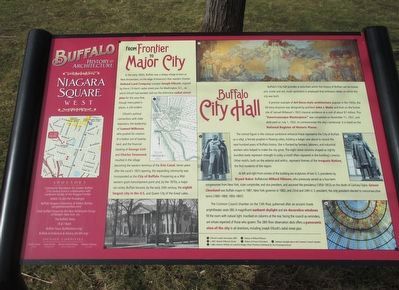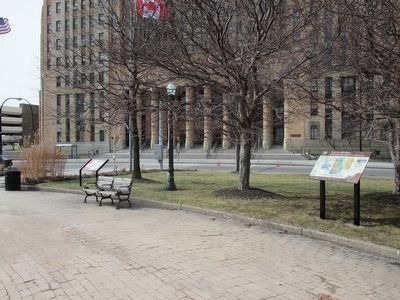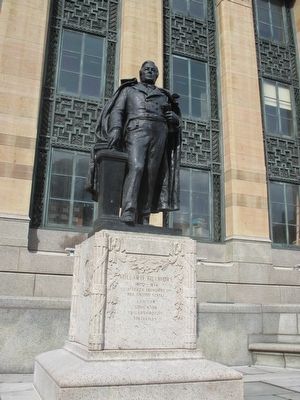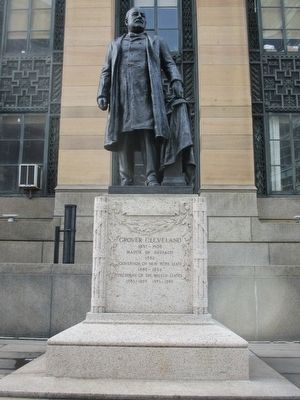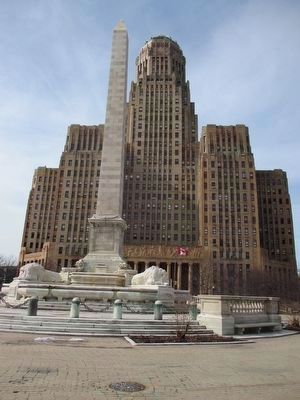Downtown in Buffalo in Erie County, New York — The American Northeast (Mid-Atlantic)
From Frontier to Major City / Buffalo City Hall
Buffalo History and Architecture
— Niagara Square West —
From Frontier to Major City
In the early 1800s, Buffalo was a sleepy village known as New Amsterdam, on the edge of America's then western frontier. Holland Land Company surveyor Joseph Ellicott, inspired by Pierre L'Enfant's radial street plan for Washington D.C., on which Ellicott had worked, laid out the distinctive radial street plan for this area that, though interrupted in places, is still evident.
Ellicott's political connections with state legislators, the leadership of Samuel Wilkeson, who pushed for the creation of a harbor out of swampland, and the financial backing of George Coit and Charles Townsend, resulted in the village becoming the western terminus of the Erie Canal. Seven years after the canal's 1825 opening, the expanding community was incorporated as the City of Buffalo. Prospering as a Mid-western grain transshipment point and, by the 1870s, a major rail center, Buffalo became, by the early 29th century, the eighth largest city in the U.S. and Queen City of the Great Lakes.
Buffalo City Hall
Buffalo's City Hall provides a vista from which the history of Buffalo can be traced, and, inside and out, much symbolism is employed that embraces ideals on which the city was built.
A premier example of Art Deco-style architecture popular in the 1920's, the 28-story structure was designed by architect John J. Wade and built on the former site of Samuel Wilkeson's 1823 classical residence at a cost of about $7 million. This "Americanesque Masterpiece" was completed on November 11, 1931, and dedicated on July 1, 1932, to commemorate the city's centennial. It is listed on the National Register of Historic Places.
The central figure in the colossal sandstone entrance frieze represents the City of Buffalo as a sibyl, a female prophet in flowing robes, holding a ledger and about to record the next hundred years of Buffalo history. She is flanked by farmers, laborers, and industrial workers who helped to make the city great. The eight stone columns shaped as tightly bundled reed represent strength in unity, a motif often repeated in the building's interior. Other motifs, both on the exterior and within, represent themes of the Iroquois Nation, the first residents of the region.
At left and right front corners of the building are scuptures of two U.S. Presidents by Bryant Baker: Buffalonian Millard Fillmore, who previously served as a four-term congressman from New York, state comptroller, and vice-president, and assumed the presidency (1850-1853) on the death of Zachary Taylor. Grover Cleveland was Buffalo mayor in 1881, New York governor in 1882, and 22nd and 24th U.S. president, the only president elected to nonconsecutive
terms (1885-1889), 1893-1897).
The Common Council chamber on the 13th floor, patterned after an ancient Greek amphitheater, seats 380. A magnificent sunburst skylight and six decorative windows fill the room with natural light, Inscribed on columns at the rear, facing the council as reminders, are virtues expected of those who govern. The 28th floor observation deck offers a panoramic view of the city in all directions, including Joseph Ellicott's radial street plan.
1) Ellicott's radial street plan, 1804
2) c.1823 Samuel Wilkeson House
3) Lobby mural by William de Leftwich Dodge, titled "Frontiers Unfettered by Any Frowning Fortress"
4) Statue of Millard Fillmore
5) Statue of Grover Cleveland
6) Sunburst skylight above the Common Council chamber
Erected by Community Foundation for Greater Buffalo 21st Century Fund in collaboration with Landmark Society of the Niagara Frontier, et al.
Topics and series. This historical marker is listed in these topic lists: Architecture • Government & Politics • Settlements & Settlers • Waterways & Vessels. In addition, it is
included in the Art Deco, the Erie Canal, the Former U.S. Presidents: #12 Zachary Taylor, the Former U.S. Presidents: #13 Millard Fillmore, and the Former U.S. Presidents: #22 and #24 Grover Cleveland series lists. A significant historical date for this entry is November 11, 1931.
Location. 42° 53.193′ N, 78° 52.709′ W. Marker is in Buffalo, New York, in Erie County. It is in Downtown. Marker can be reached from the intersection of Niagara Square and Niagara Street. Marker is across the roadway from City Hall, facing the McKinley Monument. Touch for map. Marker is at or near this postal address: 65 Niagara Square, Buffalo NY 14202, United States of America. Touch for directions.
Other nearby markers. At least 8 other markers are within walking distance of this marker. Buffalo Burns!!! (a few steps from this marker); Niagara Square (a few steps from this marker); William McKinley (within shouting distance of this marker); From Social Center to Civic Center (within shouting distance of this marker); Our Legacy of Abundant Water (within shouting distance of this marker); "...With Liberty and Justice for All." (within shouting distance
of this marker); Charles R. Turner (about 300 feet away, measured in a direct line); Samuel Manning Welch (about 400 feet away). Touch for a list and map of all markers in Buffalo.
Also see . . .
1. Buffalo as an Architectural Museum - Buffalo City Hall. (Submitted on February 29, 2016, by Anton Schwarzmueller of Wilson, New York.)
2. Buffalo City Hall. National Register of Historic Places form, National Archives. (Submitted on September 17, 2023, by Anton Schwarzmueller of Wilson, New York.)
Credits. This page was last revised on September 17, 2023. It was originally submitted on February 29, 2016, by Anton Schwarzmueller of Wilson, New York. This page has been viewed 618 times since then and 28 times this year. Photos: 1, 2, 3, 4, 5. submitted on February 29, 2016, by Anton Schwarzmueller of Wilson, New York.
